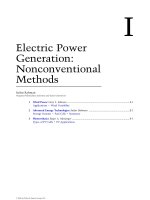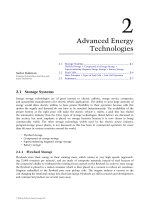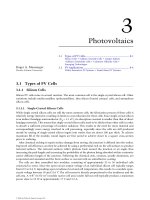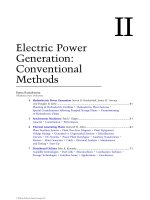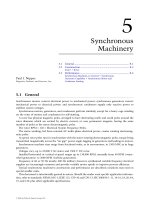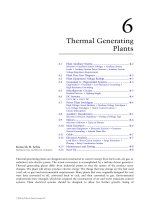power system stability and control chuong (1)
Bạn đang xem bản rút gọn của tài liệu. Xem và tải ngay bản đầy đủ của tài liệu tại đây (232.54 KB, 8 trang )
33
Power Quality
Monitoring
Patrick Coleman
Alabama Power Company
33.1 Selecting a Monitoring Point 33-1
33.2 What to Monitor 33-2
33.3 Selecting a Monitor 33-2
Voltage
.
Voltage Waveform Disturbances
.
Current
Recordings
.
Current Waveshape Disturbances
.
Harmonics
.
Flicker
.
High Frequency Noise
.
Other Quantities
33.4 Summary 33-8
Many power quality problems are caused by inadequate wiring or improper grounding. These problems
can be detected by simple examination of the wiring and grounding systems. Another large population
of power quality problems can be solved by spotchecks of voltage, current, or harmonics using hand held
meters. Some problems, however, are intermittent and require longer-term monitoring for solution.
Long-term power quality monitoring is largely a problem of data management. If an RMS value of
voltage and current is recorded each electrical cycle, for a three-phase system, about 6 gigabytes of data
will be produced each day. Some equipment is disrupted by changes in the voltage waveshape that may
not affect the rms value of the waveform. Recording the voltage and current waveforms will result in
about 132 gigaby tes of data per day. While modern data storage technologies may make it feasible to
record every electrical cycle, the task of detecting power quality problems within this mass of data is
daunting indeed.
Most commercially available power quality monitoring equipment attempts to reduce the recorded
data to manageable levels. Each manufacturer has a generally proprietary data reduction algorithm. It is
critical that the user understand the algorithm used in order to properly interpret the results.
33.1 Selecting a Monitoring Point
Power quality monitoring is usually done to either solve an existing power quality problem, or to
determine the electrical environment prior to installing new sensitive equipment. For new equipment, it
is easy to argue that the monitoring equipment should be installed at the point nearest the point of
connection of the new equipment. For power quality problems affecting existing equipment, there is
frequently pressure to determine if the problem is being caused by some external source, i.e., the utility.
This leads to the installation of monitoring equipment at the service point to try to detect the source of
the problem. This is usually not the optimum location for monitoring equipment. Most studies suggest
that 80% of power quality problems originate within the facilit y. A monitor installed on the equipment
being affected will detect problems originating within the facility, as well as problems originating on the
utility. Each type of event has distinguishing characteristics to assist the engineer in correctly identifying
the source of the disturbance.
ß 2006 by Taylor & Francis Group, LLC.
33.2 What to Monitor
At minimum, the input voltage to the affected equipment should be monitored. If the equipment is
single phase, the monitored voltage should include at least the line-to-neutral voltage and the neutral-
to-ground voltages. If possible, the line-to-ground voltage should also be monitored. For three-phase
equipment, the voltages may either be monitored line to neutral, or line to line. Line-to-neutral voltages
are easier to understand, but most three-phase equipment operates on line-to-line voltages. Usually, it is
preferable to monitor the voltage line to line for three-phase equipment.
If the monitoring equipment has voltage thresholds which can be adjusted, the thresholds should be
set to match the sensitive equipment voltage requirements. If the requirements are not known, a good
starting point is usually the nominal equipment voltage plus or minus 10%.
In most sensitive equipment, the connection to the source is a rectifier, and the critical voltages are
DC. In some cases, it may be necessary to monitor the critical DC voltages. Some commercial power
quality monitors are capable of monitoring AC and DC simultaneously, while others are AC only.
It is frequently useful to monitor current as well as voltage. For example, if the problem is being
caused by voltage sags, the reaction of the current during the sag can help determine the source of the
sag. If the current doubles when the voltage sags 10%, then the cause of the sag is on the load side of
the current monitor point. If the current increases or decreases 10–20% during a 10% voltage sag,
then the cause of the sag is on the source side of the current monitoring point.
Sensitive equipment can also be affected by other environmental factors such as temperature,
humidity, static, harmonics, magnetic fields, radio frequency interference (RFI), and operator error or
sabotage. Some commercial monitors can record some of these factors, but it may be necessary to install
more than one monitor to cover every possible source of disturbance.
It can also be useful to record power quantity data while searching for power quality problems. For
example, the author found a shortcut to the source of a disturbance affecting a wide area by using the
power quantity data. The recordings revealed an increase in demand of 2500 KW immediately after
the disturbance. Asking a few questions quickly led to a nearby plant with a 2500 KW switched load
that was found to be malfunctioning.
33.3 Selecting a Monitor
Commercially available monitors fall into two basic categories: line disturbance analyzers and voltage
recorders. The line between the categories is becoming blurred as new models are developed. Voltage
recorders are primarily designed to record voltage and current stripchar t data, but some models are
able to capture waveforms under certain circumstances. Line disturbance analyzers are designed to
capture voltage events that may affect sensitive equipment. Generally, line disturbance analyzers are not
good voltage recorders, but newer models are better than previous designs at recording voltage
stripcharts.
In order to select the best monitor for the job, it is necessary to have an idea of the type of disturbance
to be recorded, and an idea of the operating characteristics of the available disturbance analyzers. For
example, a common power quality problem is nuisance tripping of variable speed drives. Variable speed
drives may trip due to the waveform disturbance created by power factor correction capacitor switching,
or due to high or low steady state voltage, or, in some cases, due to excessive voltage imbalance. If the
drive trips due to high voltage or waveform disturbances, the drive diagnostics will usually indicate an
overvoltage code as the cause of the trip. If the voltage is not balanced, the drive will draw significantly
unbalanced currents. The current imbalance may reach a level that causes the drive to trip for input
overcurrent. Selecting a monitor for variable speed drive tripping can be a challenge. Most line
disturbance analyzers can easily capture the waveshape disturbance of capacitor switching, but they
are not good voltage recorders, and may not do a good job of reporting high steady state voltage. Many
line disturbance analyzers cannot capture voltage unbalance at all, nor will they respond to current
ß 2006 by Taylor & Francis Group, LLC.
events unless there is a corresponding voltage event. Most voltage and current recorders can easily
capture the high steady state voltage that leads to a drive trip, but they may not capture the capacitor
switching waveshape disturbance. Many voltage recorders can capture voltage imbalance, current
imbalance, and some of them will trigger a capture of voltage and current during a current event,
such as the drive tripping off.
To select the best monitor for the job, it is necessary to understand the characteristics of the available
monitors. The following sections will discuss the various types of data that may be needed for a power
quality investigation, and the characteristics of some commercially available monitors.
33.3.1 Voltage
The most commonly recorded parameter in power quality investigations is the RMS voltage delivered to
the equipment. Manufacturers of recording equipment use a variety of techniques to reduce the volume
of the data recorded. The most common method of data reduction is to record Min=Max=Average data
over some interval. Figure 33.1 shows a strip chart of rms voltages recorded on a cycle-by-cycle basis.
Figure 33.2 shows a Min=Max=Average chart for the same time period. A common recording period is 1
week. Typical recorders will use a recording interval of 2–5 minutes. Each recording interval will produce
121
120.5
120
119
119.5
118.5
FIGURE 33.1 RMS voltage stripchart, taken cycle by cycle.
Maximum 1 Cycle Voltage
121
120.5
120
119.5
119
118.5
Minimum 1 Cycle Voltage
Average Of Every Cycle In Recording Interval
FIGURE 33.2 Min=Max=Average stripchart, showing the minimum single cycle voltage, the maximum single cycle
voltage, and the average of every cycle in a recording interval. Compare to the Fig. 33.1 stripchart data.
ß 2006 by Taylor & Francis Group, LLC.
three numbers: the rms voltage of the highest 1 cycle, the lowest 1 cycle, and the average of every cycle
during the interval. This is a simple, easily understood recording method, and it is easily implemented
by the manufacturer. There are several drawbacks to this method. If there are several events during a
recording inter val, only the event with the largest deviation is recorded. Unless the recorder records the
event in some other manner, there is no time-stamp associated with the events, and no duration
available. The most critical deficiency is the lack of a voltage profile during the event. The voltage
profile provides significant clues to the source of the event. For example, if the event is a voltage sag, the
minimum voltage may be the same for an event caused by a distant fault on the utility system, and for a
nearby large motor start. For the distant fault, however, the voltage will sag nearly instantaneously, stay
at a fairly constant level for 3–10 cycles, and almost instantly recover to full voltage, or possibly a slightly
higher voltage if the faulted section of the utility system is separated. For a nearby motor start, the
voltage will drop nearly instantaneously, and almost immediately begin a gradual recovery over 30–180
cycles to a voltage somewhat lower than before. Figure 33.3 shows a cycle-by-cycle recording of a
simulated adjacent feeder fault, followed by a simulation of a voltage sag caused by a large motor star t.
Figure 33.4 shows a Min=Max=Average recording of the same two events. The events look quite
Adjacent Feeder Fault Sag
80
85
90
95
100
105
110
115
120
125
130
Large Motor Start Sag
FIGURE 33.3 Cycle-by-cycle rms stripchart showing two voltage sags. The sag on the left is due to an adjacent
feeder fault on the supply substation, and the sag on the right is due to a large motor start. Note the difference in the
voltage profile during recovery.
130
Min/Ave/Max Chart
Adjacent Feeder Fault Voltage Sag Large Motor Start Voltage Sag
125
120
115
110
105
100
95
90
85
80
FIGURE 33.4 Min=Max=Average stripchar t of the same voltage sags as Fig. 33.3. Note that both sags look almost
identical. Without the recovery detail found in Fig. 33.3, it is difficult to determine a cause for the voltage sags.
ß 2006 by Taylor & Francis Group, LLC.
similar when captured by the Min=Max=Average recorder, while the cycle-by-cycle recorder reveals the
difference in the voltage recovery profile.
Some line disturbance analyzers allow the user to set thresholds for voltage events. If the
voltage exceeds these thresholds, a short duration stripchart is captured showing the voltage profile
during the event. This short duration stripchart is in addition to the long duration recordings, meaning
that the engineer must look at several different charts to find the needed information.
Some voltage recorders have user-programmable thresholds, and record deviations at a higher
resolution than voltages that fall within the thresholds. These deviations are incorporated into the
stripchart, so the user need only open the stripchart to determine, at a glance, if there are any significant
events. If there are events to be examined, the engineer can immediately ‘‘zoom in’’ on the portion of the
stripchart with the event.
Some voltage recorders do not have user-settable thresholds, but rather choose to capture events based
either on fixed default thresholds or on some type of significant change. For some users, fixed thresholds
are an advantage, while others are uncomfortable with the lack of control over the meter function. In
units with fixed thresholds, if the environment is normally somewhat disturbed, such as on a welder
circuit at a motor control center, the meter memor y may fill up with insignificant events and the
monitor may not be able to record a significant event when it occurs. For this reason, monitors with
fixed thresholds should not be used in electrically noisy environments.
33.3.2 Voltage Waveform Disturbances
Some equipment can be disturbed by changes in the voltage waveform. These waveform changes may
not significantly affect the rms voltage, yet may still cause equipment to malfunction. An rms-only
recorder may not detect the cause of the malfunction. Most line disturbance analyzers have some
mechanism to detect and record changes in voltage waveforms. Some machines compare portions of
successive waveforms, and capture the waveform if there is a significant deviation in any portion of the
waveform. Others capture waveforms if there is a significant change in the rms value of successive
waveforms. Another method is to capture waveforms if there is a significant change in the voltage total
harmonic distortion (THD) between successive cycles.
The most common voltage waveform change that may cause equipment malfunction is the
disturbance created by power factor correction capacitor switching. When capacitors are energized,
a disturbance is created that lasts about 1 cycle, but does not result in a significant change in the
rms voltage. Figure 33.5 shows a typical power factor correction capacitor switching event.
33.3.3 Current Recordings
Most modern recorders are capable of simul-
taneous voltage and current recordings. Current
recordings can be useful in identifying the cause
of power quality disturbances. For example, if a
20% voltage sag (to 80% of full voltage) is accom-
panied by a small change in current (plus or minus
about 30%), the cause of the voltage sag is usually
upstream (toward the utility source) of the moni-
toring point. If the sag is accompanied by a large
increase in current (about 100%), the cause of the
sag is downstream (toward the load) of the moni-
toring point. Figure 33.6 shows the rms voltage
and current captured during a motor start down-
stream of the monitor. Notice the large current
increase during starting and the corresponding
small decrease in voltage.
FIGURE 33.5 Typical voltage waveform distur-
bance caused by power factor correction capacitor
energization.
ß 2006 by Taylor & Francis Group, LLC.
Some monitors allow the user to select current thresholds that will cause the monitor to capture both
voltage and current when the current exceeds the threshold. This can be useful for detecting over- and
under-currents that may not result in a voltage disturbance. For example, if a small, unattended machine
is tripping off unexpectedly, it would be useful to have a snapshot of the voltage and current just prior to
the trip. A threshold can be set to trigger a snapshot when the current goes to zero. This snapshot can be
used to determine if the input voltage or current was the cause of the machine trip.
33.3.4 Current Waveshape Disturbances
Very few monitors are capable of capturing changes in current waveshape. It is usually not necessary to
capture changes in current waveshape, but in some special cases this can be useful data. For example,
inrush current waveforms can provide more useful information than inrush current rms data. Figure
33.7 shows a significant change in the current waveform when the current changes from zero to nearly
100 amps peak. The shape of the waveform, and the phase shift with respect to the voltage waveform,
confirm that this current increase was due to an induction motor start. Figure 33.7 shows the first few
cycles of the event shown in Fig. 33.6.
33.3.5 Harmonics
Harmonic distortion is a growing area of concern. Many commercially available monitors are capable
of capturing harmonic snapshots. Some monitors have the ability to capture harmonic stripchart data.
In this area, it is critical that the monitor produce accurate data. Some commercially available monitors
have deficiencies in measuring harmonics. Monitors generally capture a sample of the voltage and current
waveforms, and perform a Fast Fourier Transform to produce a harmonic spectrum. According to the
Nyquist Sampling Theorem, the input waveform must be sampled at least twice the highest frequency
that is present in the waveform. Some manufacturers interpret this to mean the highest frequency of
interest, and adjust their sample rates accordingly. If the input signal contains a frequency that is above
the maximum frequency that can be correctly sampled, the high frequency signal may be ‘‘aliased,’’ that is,
it may be incorrectly identified as a lower frequency harmonic. This may lead the engineer to search for a
100
105
110
115
120
125
130
70
60
50
40
30
20
10
0
Voltage
RMS Voltage
RMS Current
Current
FIGURE 33.6 RMS stripcharts of voltage and current during a large current increase due to a motor start
downstream of the monitor point.
ß 2006 by Taylor & Francis Group, LLC.
solution to a harmonic problem that does not exist. The aliasing problem can be alleviated by sampling at
higher sample rates, and by filtering out frequencies above the highest frequency of interest. The sample
rate is usually found in the manufacturer’s literature, but the presence of an antialiasing filter is not usually
mentioned in the literature.
33.3.6 Flicker
Some users define flicker as the voltage sag that occurs when a large motor starts. Other users regard
flicker as the frequent, small changes in voltage that occur due to the operation of arc furnaces, welders,
chippers, shredders, and other varying loads. Nearly any monitor is capable of adequately capturing
voltage sags due to occasional motor starts. The second definition of flicker is more difficult to monitor.
In the absence of standards, several manufacturers have developed proprietary ‘‘flicker’’ meters. In recent
years, an effort has been made to standardize the definition of ‘‘flicker,’’ and to standardize the
performance of flicker meters. At the time of this writing, several monitor manufacturers are attempting
to incorporate the standardized flicker function into their existing products.
33.3.7 High Frequency Noise
Sensitive electronic equipment can be susceptible to higher frequency signals imposed on the voltage
waveform. These signals may be induced on the conductors by sources such as radio transmitters or
arcing devices such as fluorescent lamps, or they may be conductively coupled by sources such as power
line carrier energy management systems. A few manufacturers include detection circuitry for high
frequency signals imposed on the voltage waveform.
33.3.8 Other Quantities
It may be necessary to find a way to monitor other quantities that may affect sensitive equipment.
Examples of other quantities are temperature, humidity, v ibration, static electricity, magnetic fields,
fluid flow, and air flow. In some cases, it may also become necessary to monitor for vandalism or
Voltage Waveform
200
150
100
50
0
−50
−100
−150
−200
150
100
50
0
−50
−100
−150
Current
Voltage
Current
FIGURE 33.7 Voltage and current waveforms for the first few cycles of the current increase illustrated in Fig. 33.6.
ß 2006 by Taylor & Francis Group, LLC.
sabotage. Most power quality monitors cannot record these quantities, but other devices exist that can
be used in conjunction with power quality monitors to find a solution to the problem.
33.4 Summary
Most power quality problems can be solved with simple hand-tools and attention to detail. Some
problems, however, are not so easily identified, and it may be necessary to monitor to correctly identify
the problem. Successful monitoring involves several steps. First, determine if it is really necessary to
monitor. Second, decide on a location for the monitor. Generally, the monitor should be installed close
to the affected equipment. Third, decide what quantities need to be monitored, such as voltage, current,
harmonics, and power data. Try to determine the types of events that can disturb the equipment, and
select a meter that is capable of detecting those types of events. Fourth, decide on a monitoring period.
Usually, a good first choice is at least one business cycle, or at least 1 day, and more commonly, 1 week. It
may be necessary to monitor until the problem recurs. Some monitors can record indefinitely by
discarding older data to make space for new data. These monitors can be installed and left until the
problem recurs. When the problem recurs, the monitoring should be stopped before the event data is
discarded.
After the monitoring period ends, the most difficult task begins — interpreting the data. Modern
power quality monitors produce reams of data during a disturbance. Data interpretation is largely a
matter of experience, and Ohm’s law. There are many examples of disturbance data in books such as
The BMI Handbook of Power Signatures, Second Edition , and the Dranetz Field Handbook for Power
Quality Analysis.
ß 2006 by Taylor & Francis Group, LLC.




